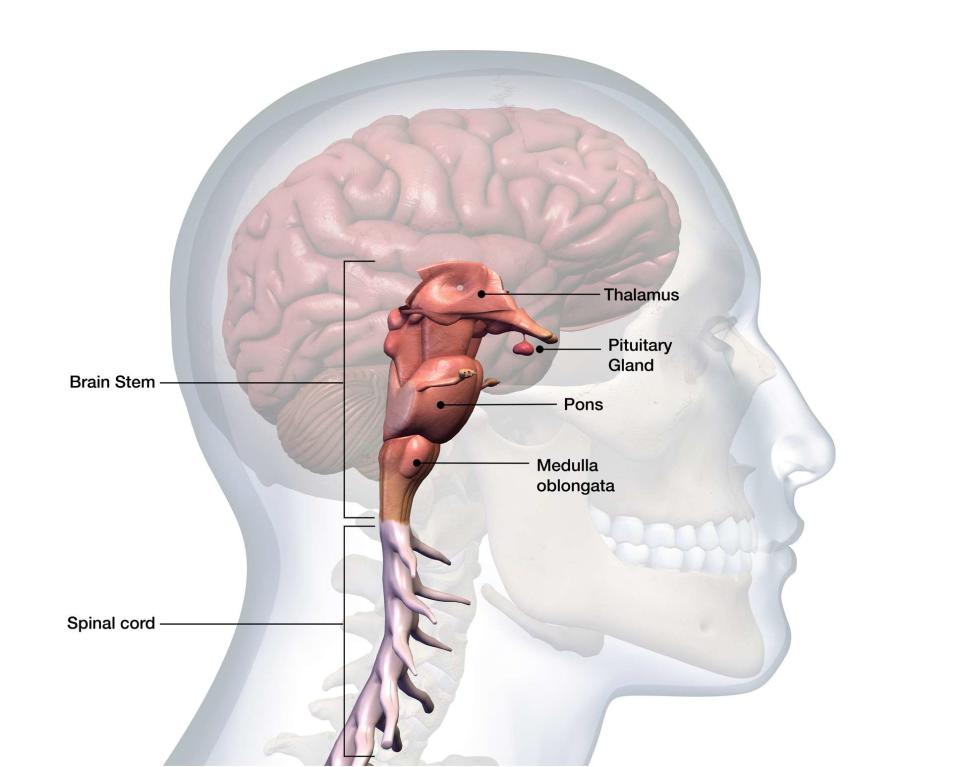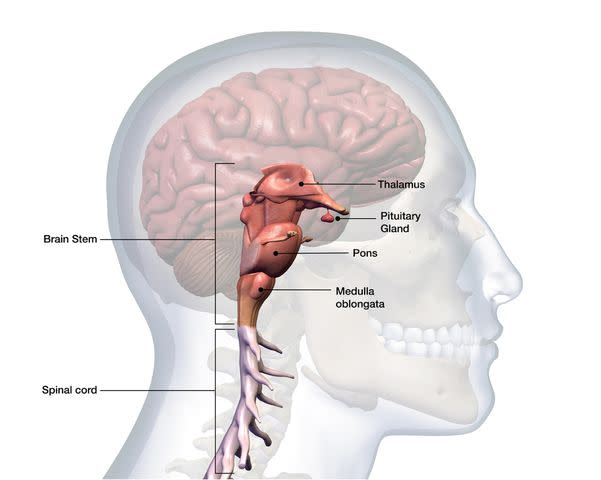The Anatomy of the Medulla Oblongata
The medulla oblongata relays critical signals between the brain and body

Medically reviewed by Isabel Casimiro, MD PhDFact checked by Nick Blackmer
The medulla oblongata is a tail-like structure at the base of the brain that connects the brain to the spinal cord. It carries signals from the brain to the rest of the body for essential life functions like breathing, circulation, swallowing, and digestion.
While every part of the brain is important in its own way, the work of the medulla oblongata is essential for sustaining life.
This article explains the anatomy and function of the medulla oblongata and conditions that can affect it.

Medulla Oblongata Anatomy
There are three structures located in front of the cerebellum (the part of the hindbrain responsible for coordinating movement). These structures sit at the base of the brain (brainstem) and connect to the spinal cord. They include:
Medulla oblongata
Midbrain (responsible for hearing, vision, movement, sleep, and arousal)
Pons (responsible for eye movement, motor function, hearing, and taste)
The cone-shaped medulla oblongata sits beneath the midbrain and pons. It contains both white and gray matter.
What Is White and Gray Matter?
White matter makes up the deeper brain tissue. It contains nerve fibers and nerve cells covered by myelin, a substance that gives the tissue its white color, protects it, and speeds electrical signals.
Gray matter is the tissue on the surface of the brain. It contains neuron cell bodies, which give it its gray color.
Related: White Matter in the Brain
The medulla oblongata is divided into two parts:
Superior section (upper, open part)
Inferior section (lower, closed part)
The superior section connects to the brain’s fourth ventricle (one of the cavities filled with cerebral spinal fluid), while the inferior section connects to the spinal cord.
The brainstem—including the midbrain, pons, and medulla—house the starting points of 10 of the 12 cranial nerves.
Function of the Medulla Oblongata
The cranial nerves—a dozen pairs of nerves that link your brain to your head, neck, and torso—facilitate the work of the brainstem.
Of the 10 cranial nerves that begin in the brainstem, nerves nine through 12 start in the medulla oblongata:
Cranial nerve 9 (glossopharyngeal nerve) controls swallowing, taste, and saliva production
Cranial nerve 10 (vagus nerve) plays a role in breathing, heart function, digestion, and hormones
Cranial nerve 11 (accessory nerve) controls the upper back and neck muscles
Cranial nerve 12 (hypoglossal nerve) controls tongue movement, speech, and swallowing
Nerves three through eight begin in the midbrain and pons.
Together, all sections of the brainstem and their nerves relay signals from the brain to the spinal cord and then to the rest of the body to control the autonomic nervous system. This system is responsible for most basic life functions that the body performs without thought, including:
Breathing
Maintaining blood pressure and temperature
Circulating blood
Digestion
Regulating sleep patterns
Related: The Anatomy of the Brain
Associated Conditions
Rarely, malformations in the medulla can occur at birth. However, many problems with this area occur due to physical injury. In addition, they may happen due to drug overdoses or strokes.
When the medulla is damaged, the critical functions of that part of the brain can result in severe disability or brain death. Without the function of the brainstem, survival is not possible.
In addition to injury, several specific conditions can affect the medulla oblongata.
Lateral Medullary Syndrome (Wallenberg Syndrome)
Lateral medullary syndrome (also called Wallenberg syndrome) is a common form of stroke that affects the medulla. This type of stroke is caused by a clot in or injury to a vertebral artery, a large vein that runs along either side of the neck.
Symptoms of this syndrome include:
Headache
Double vision
Vertigo (dizziness)
Trouble swallowing or speaking
Lack of sensation in the face
Related: Overview of a Stroke of the Medulla Oblongata
Medial Medullary Syndrome
A blockage in the vertebral or spinal artery causes medial medullary syndrome, also called Dejerine-Roussy syndrome.
This condition results from a lack of blood blow through parts of the medulla. It can cause paralysis in the legs, arm, face, and tongue.
Bilateral Medial Medullary Syndrome
Bilateral medial medullary syndrome is a rare combination of lateral medullary syndrome and medial medullary syndrome.
It results in almost complete quadriplegia (paralysis of all four limbs). Facial nerves and respiratory function are often not affected by this syndrome.
Related: Brainstem Stroke Symptoms, Diagnosis, and Syndromes
Evaluating the Medulla Oblongata
Detecting damage to the medulla and other brainstem parts can be difficult. That’s because people who have brain injuries may not be able to fully participate in an examination.
The following are a few examples of tests that may help determine the level of function in the brainstem:
Cranial nerve assessment, a physical assessment to see what tasks you can perform
Computer tomography (CT) scan, a combination of a series of X-rays
Magnetic resonance imaging (MRI), which uses magnetic fields and radio waves to generate images
Brain perfusion scan, a test that shows which areas of the brain are receiving blood flow
Summary
The medulla oblongata is one of three parts of the brainstem. Ten of the 12 cranial nerves begin in the brainstem. Of those, four begin in the medulla oblongata. These nerves control swallowing, taste, breathing, heart function, digestion, upper back and neck muscles, and tongue movement.
Injuries and strokes most commonly cause problems with the medulla oblongata. Tests to determine damage in the brainstem may include scans and functional tests.

 money
money 